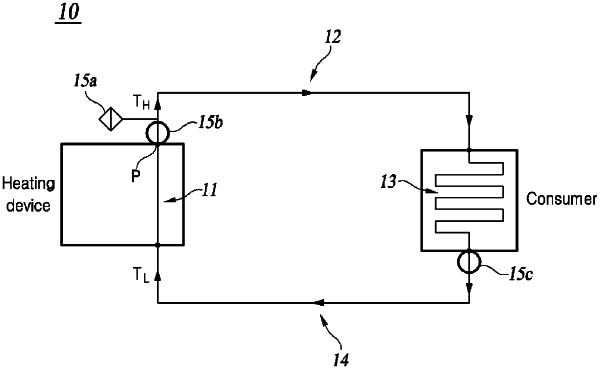| CPC F24D 19/1048 (2013.01) [F24D 10/00 (2013.01)] | 13 Claims |

|
1. A method for analyzing a district heating network analysis including pipes and fluids inside the pipes, method comprising:
a pipe data receiving process of receiving, by a processor, pipe data representing a structure of the pipes;
an input data receiving process of receiving, by the processor, input data on at least one of flow of the fluids or a physical state of the district heating network;
a calculation process of calculating calculation data on at least one of the flow of the fluids or the physical state of the district heating network by the processor by using of the input data and the pipe data; and
a storing process of storing, in a time-sequence manner, analysis data including at least some of the calculation data, at least some of the input data, and at least some of the pipe data by a storage device, wherein the input data comprises:
the analysis data; and
real-time data on at least one of the flow of the fluids or the physical state of the district heating network transmitted to the processor in preset time period from a real-time data transmitting device installed in the district heating network,
wherein the calculation process comprises:
a first calculation process in which the processor calculates a first calculation data on the flow of the fluids by using the input data and the pipe data; and
a second calculation process in which the processor calculates a second calculation data on movement of heat inside the district heating network by using the first calculation data, the input data, and the pipe data,
wherein receiving, the processor, the pipe data comprises:
obtaining, by a pipe data acquisition unit, node data on at least one node including a point at which a flow area of the fluids is separated along a flowing direction of the fluids, a point at which a plurality of mutually separated flow areas of the fluids are combined along the flowing direction of the fluids, a point at which a valve is installed, and a point at which the cross-sectional area of the pipes changes;
obtaining unit pipe data on a heat loss coefficient, a length, and the cross-sectional area of at least one of a plurality of unit pipes defined by at least one of the nodes;
obtaining, by the pipe data acquisition unit, confluence point data on a confluence point at which the plurality of mutually separated flow areas of the fluids are combined along the flowing direction of the fluids; and
receiving, by the processor, the confluence point data, the unit pipe data, and the node data, wherein the pipe data comprises the confluence point data, the unit pipe data, and the node data, and
wherein the calculation process is calculating data on temperature of the node using the equation
 when the node is not the confluence point, wherein Ten is a fluid temperature at the ending point, Ts is a fluid temperature at starting point, d is a pipe internal diameter, Tg is an underground temperature, f is a heat loss coefficient, and calculating data on the temperature of the node using the equation
 when the node is the confluence point, wherein Ten is temperature of fluid at confluence point, Ten1 is fluid temperature at ending point, F1 is a first unit pipe flow rate, and F2 is second unit pipe flow rate.
|